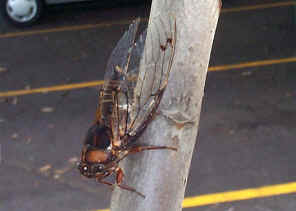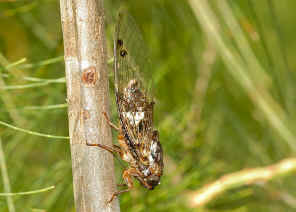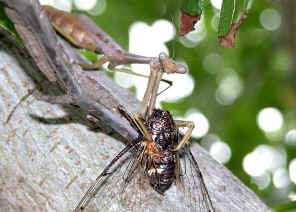|
|
Floury Baker - Aleeta curvicosta (Abricta curvicosta)
Family Cicadidae
- This page contains pictures and information about Floury Baker Cicadas that we found in the Brisbane area, Queensland, Australia.

- Body length 35mm, male
- The Floury Baker Cicada is dark brown in colour with lighter brown centre line on thorax. Its abdomen is rather 'floury' look so has its common name. Wings are clean, with two spots near the tip on each forewing. At mid summer, the Floury Baker Cicadas can be found on almost every trees in my office front yard in Moorooka and in our backyard in Eight Mile Plains. They are common in Brisbane. Male and female look very similar and about the same size.



- One thing unusual is that they alway rest on tree trunk with face downwards. Most, if not all, other cicadas face upwards. The pictures were taken in early summer when a Floury Baker Cicada came to visit us in our backyard.



- Their calling songs are distinctive. They start with zeep-zeep-zeep phrases, about one zeep per second, then faster and faster until become a long zeep sound for 10 seconds to over minutes, then stop and start again. A cicada on one tree will follow the zeep sound of a cicada on another tree far away. It seems that they are comparing the loudness of their songs with each other. They sing from day to dusk.



- Floury Baker has adapted a wide variety of habitats and plant species. The can be found in bushlands and in gardens. They can be found sitting on paper barks, and other native stubs. They can be found on stems and main tree trunks.
-



- Female
- Floury Baker Cicada tend to be solitary.
 Sound
of Floury Baker Cicada.
Sound
of Floury Baker Cicada.
The Cicada Song
8.0 seconds of sound waveform and spectrum.
The calling song do not have a distinct carrier and pulse format. Just a random hiss-like tone from 300Hz to 4KHz.
The Cicada Sound beside calling for mate
Different cicada species sings different song. From the song we can tell the cicada species.
2004, a hot summer weekend when I was working in front of my computer on this Brisbane Insects and Spiders web site, as usual I heard many of this Floury Baker Cicadas singing outside in our backyard on the Maple trees. Suddenly I heard a new cicada song. The song had the different pattern which I had never heard before. I thought there must be a new species of cicadas came to visit us. I immediately took my camera outside and look for it.
What I found was not a new cicada species. Instead it was a Floury Baker Cicada attacked by a Praying Mantid. The cicada might try to deter the mantid but with no luck.
- Reference:
- 1. Wildlife of Greater Brisbane - Queensland Museum: Brisbane (1997), p82.
- 2. Species Aleeta curvicosta (Germar, 1834) - Australian Faunal Directory, Australian Biological Resources Study.





